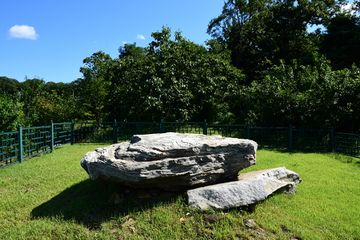"강화 대산리 지석묘"의 두 판 사이의 차이
(→영문) |
|||
| (사용자 2명의 중간 판 10개는 보이지 않습니다) | |||
| 24번째 줄: | 24번째 줄: | ||
지석묘는 청동기 시대의 대표적인 무덤으로 고인돌이라고도 부르며, 주로 경제력이 있거나 정치권력을 가진 지배층의 무덤으로 알려져 있다. 우리나라의 고인돌은 4개의 받침돌을 세워 돌방을 만들고 그 위에 거대하고 평평한 덮개돌을 올려 놓은 탁자식과 땅속에 돌방을 만들고 작은 받침돌을 세운 뒤 그 위에 덮개돌을 올린 바둑판식으로 구분된다. | 지석묘는 청동기 시대의 대표적인 무덤으로 고인돌이라고도 부르며, 주로 경제력이 있거나 정치권력을 가진 지배층의 무덤으로 알려져 있다. 우리나라의 고인돌은 4개의 받침돌을 세워 돌방을 만들고 그 위에 거대하고 평평한 덮개돌을 올려 놓은 탁자식과 땅속에 돌방을 만들고 작은 받침돌을 세운 뒤 그 위에 덮개돌을 올린 바둑판식으로 구분된다. | ||
| − | 강화 고려산 동쪽 봉우리인 북산의 해발 약 20m 산등성이에 있는 이 고인돌은 탁자식이다. 약간의 흙과 자갈로 지면을 높이고 그 위에 받침돌을 세운 뒤 덮개돌을 올렸으나 현재는 무너져 내려앉았다. 덮개돌의 크기는 길이 3.68m, 너비 2.6m이다. 강화 지역에서 군을 이루지 않고 독립적으로 분포하고 있는 대형에 속하는 고인돌로 2000년 12월 2일 유네스코 | + | 강화 고려산 동쪽 봉우리인 북산의 해발 약 20m 산등성이에 있는 이 고인돌은 탁자식이다. 약간의 흙과 자갈로 지면을 높이고 그 위에 받침돌을 세운 뒤 덮개돌을 올렸으나 현재는 무너져 내려앉았다. 덮개돌의 크기는 길이 3.68m, 너비 2.6m이다. 강화 지역에서 군을 이루지 않고 독립적으로 분포하고 있는 대형에 속하는 고인돌로 2000년 12월 2일 유네스코 세계유산으로 등록되었다. |
===영문=== | ===영문=== | ||
| − | ' | + | A dolmen is a type of megalithic tomb constructed during the Bronze Age (1500-300 BC). Dolmens are found all over the world, but 40,000 to 45,000 of them - nearly 40% of the world's total - are located on the Korean peninsula. Ganghwado Island is home to a total of 160 dolmens. Among these, 70 were inscribed on the UNESCO World Heritage List in 2000, together with others in the Hwasun and Gochang areas in Jeolla-do Province. |
| − | + | This dolmen, located on the eastern slope of Goryeosan Mountain, was a table type dolmen but has since collapsed. Table type dolmens are comprised of upright, stone slabs covered by a wide, flat capstone to create an above-ground burial chamber. Dolmens can be found alone or in groups, and among those in Ganghwa constructed alone, this dolmen in Daesan-ri is one of the largest. Its capstone measures 3.68 m in length and 2.6 m in width. This dolmen is on the UNESCO World Heritage List. | |
| − | + | ===영문 해설 내용=== | |
| + | 고인돌은 청동기 시대의 대표적인 거석무덤이다. 고인돌은 전 세계에서 발견되고 있으며, 세계 고인돌의 40%에 달하는 4만~4만 5천기의 고인돌이 한반도에서 발견되었다. 강화도에는 총 160기의 고인돌이 있으며, 이중 70기가 전라도 화순과 고창의 고인돌들과 함께 2000년 유네스코 세계유산으로 등재되었다. | ||
| + | 고려산 동쪽 산등성이에 있는 이 고인돌은 탁자식이지만 현재는 무너져 내려앉았다. 탁자식 고인돌은 받침돌을 세워 돌방을 만들고 그 위에 넓고 평평한 덮개돌을 올려서 만들어진다. 고인돌은 단독 또는 여러 기가 군집으로 발견되는데, 강화에서 단독으로 발견되는 것 중 대산리에 있는 이 고인돌은 대형에 속한다. 덮개돌의 크기는 길이 3.68m, 너비 2.6m이다. 이 고인돌은 유네스코 세계유산으로 등재되었다. | ||
| + | |||
| + | [[분류:문화유산해설문]] | ||
[[분류:인천광역시 문화유산]] | [[분류:인천광역시 문화유산]] | ||
| + | [[분류:강화군 문화유산]] | ||
[[분류:시도기념물]] | [[분류:시도기념물]] | ||
[[분류:지석묘]] | [[분류:지석묘]] | ||
| + | [[분류:2018 영문집필]] | ||
2023년 4월 10일 (월) 12:03 기준 최신판
| 강화 대산리 지석묘 Dolmen in Daesan-ri, Ganghwa |
|
| 대표명칭 | 강화 대산리 지석묘 |
|---|---|
| 영문명칭 | Dolmen in Daesan-ri, Ganghwa |
| 한자 | 江華 大山里 支石墓 |
| 주소 | 인천광역시 강화군 강화읍 대산리 1189 |
| 지정번호 | 인천광역시 기념물 제31호 |
| 지정일 | 1995.03.02 |
| 분류 | 유적건조물/무덤/무덤/지석묘 |
| 소유자 | 인천광역시 강화군청 |
| 수량/면적 | 1기 / 588㎡ |
|
|
|
해설문
국문
지석묘는 청동기 시대의 대표적인 무덤으로 고인돌이라고도 부르며, 주로 경제력이 있거나 정치권력을 가진 지배층의 무덤으로 알려져 있다. 우리나라의 고인돌은 4개의 받침돌을 세워 돌방을 만들고 그 위에 거대하고 평평한 덮개돌을 올려 놓은 탁자식과 땅속에 돌방을 만들고 작은 받침돌을 세운 뒤 그 위에 덮개돌을 올린 바둑판식으로 구분된다.
강화 고려산 동쪽 봉우리인 북산의 해발 약 20m 산등성이에 있는 이 고인돌은 탁자식이다. 약간의 흙과 자갈로 지면을 높이고 그 위에 받침돌을 세운 뒤 덮개돌을 올렸으나 현재는 무너져 내려앉았다. 덮개돌의 크기는 길이 3.68m, 너비 2.6m이다. 강화 지역에서 군을 이루지 않고 독립적으로 분포하고 있는 대형에 속하는 고인돌로 2000년 12월 2일 유네스코 세계유산으로 등록되었다.
영문
A dolmen is a type of megalithic tomb constructed during the Bronze Age (1500-300 BC). Dolmens are found all over the world, but 40,000 to 45,000 of them - nearly 40% of the world's total - are located on the Korean peninsula. Ganghwado Island is home to a total of 160 dolmens. Among these, 70 were inscribed on the UNESCO World Heritage List in 2000, together with others in the Hwasun and Gochang areas in Jeolla-do Province.
This dolmen, located on the eastern slope of Goryeosan Mountain, was a table type dolmen but has since collapsed. Table type dolmens are comprised of upright, stone slabs covered by a wide, flat capstone to create an above-ground burial chamber. Dolmens can be found alone or in groups, and among those in Ganghwa constructed alone, this dolmen in Daesan-ri is one of the largest. Its capstone measures 3.68 m in length and 2.6 m in width. This dolmen is on the UNESCO World Heritage List.
영문 해설 내용
고인돌은 청동기 시대의 대표적인 거석무덤이다. 고인돌은 전 세계에서 발견되고 있으며, 세계 고인돌의 40%에 달하는 4만~4만 5천기의 고인돌이 한반도에서 발견되었다. 강화도에는 총 160기의 고인돌이 있으며, 이중 70기가 전라도 화순과 고창의 고인돌들과 함께 2000년 유네스코 세계유산으로 등재되었다.
고려산 동쪽 산등성이에 있는 이 고인돌은 탁자식이지만 현재는 무너져 내려앉았다. 탁자식 고인돌은 받침돌을 세워 돌방을 만들고 그 위에 넓고 평평한 덮개돌을 올려서 만들어진다. 고인돌은 단독 또는 여러 기가 군집으로 발견되는데, 강화에서 단독으로 발견되는 것 중 대산리에 있는 이 고인돌은 대형에 속한다. 덮개돌의 크기는 길이 3.68m, 너비 2.6m이다. 이 고인돌은 유네스코 세계유산으로 등재되었다.
